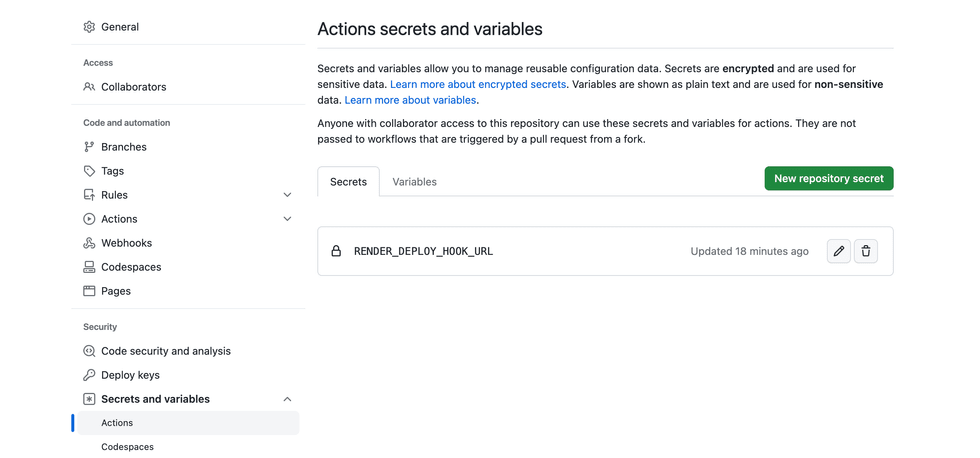Deploy Hooks
Trigger a deploy with a single HTTP request.
Deploy hooks enable you to trigger an on-demand deploy of your Render service with a single HTTP request. Use deploy hooks with:
- CI/CD environments like GitHub Actions (see an example)
- Image-backed services (to trigger a deploy when a new image is available)
- Headless CMS systems like Contentful (to trigger a deploy when content changes)
Looking for webhooks? See this article.
Triggering a deploy
Each service has a secret deploy hook URL, available from its Settings tab in the Render Dashboard:

Your deploy hook URL is a secret!
Provide the URL only to people and systems you trust to trigger deploys. If you believe a deploy hook URL has been compromised, replace it by clicking Regenerate Hook.
To trigger a deploy, send a basic GET or POST request to your service’s deploy hook URL—no special headers required.
curl https://api.render.com/deploy/srv-xyz…Deploying from an image registry
Image-backed services on Render pull and deploy a prebuilt Docker image from an external registry. These services do not automatically redeploy if a new image is pushed to the registry. You can use a deploy hook to trigger a deploy whenever an updated image is available.
To deploy a specific tag or digest, append the imgURL query parameter to your deploy hook URL:
# Append a string with this format to your deploy hook URL.
# This example deploys the image `nginx:1.26` from Docker Hub.
# Note the URL-encoding.
&imgURL=docker.io%2Flibrary%2Fnginx%401.26If you don’t provide this parameter, Render uses whichever tag or digest you’ve specified in the service’s settings.
All components of imgURL besides the tag or digest must match your service’s default image URL. Otherwise, Render rejects the deploy request.
Using with GitHub Actions
You might want to trigger a service deploy from your CI/CD environment whenever certain conditions are met (such as when all of your tests pass). Let’s set this up using deploy hooks and GitHub Actions.
1. Create a repository secret
Deploy hook URLs are secret values, so we need to make sure to store ours as a secret in our GitHub repo:
-
Go to your GitHub repo’s Settings page.
-
Click Secrets and variables > Actions.
-
Click New repository secret. Create a secret with the name
RENDER_DEPLOY_HOOK_URLand provide your deploy hook URL as the value:
2. Add a GitHub workflow
Now that we’ve added our deploy hook URL, let’s create a GitHub workflow that uses it:
- Create a
.github/workflowsdirectory in your repo if it doesn’t already exist. GitHub Actions automatically detects and runs any workflows defined in this folder. - Add a YAML file to this directory to represent your new workflow. The example below uses the file path
.github/workflows/ci.yml. - Define logic in your workflow to trigger a deploy after any prerequisite steps succeed. See the example.
- Commit all of your changes.
Example workflow
This example workflow defines a job named ci that includes two steps (Test and Deploy). The workflow runs whenever any pull request is opened against main, or when commits are pushed to main.
- The
Teststep runs the repo’s defined unit tests. - The
Deploystep executes acurlrequest to our deploy hook URL only if the current branch ismainand theTeststep succeeded.
# .github/workflows/ci.yml
on:
pull_request:
push:
branches: [main]
jobs:
ci:
runs-on: ubuntu-latest
steps:
- uses: actions/checkout@v3
- name: Test
run: |
npm install
npm run test
- name: Deploy
# Only run this step if the branch is main
if: github.ref == 'refs/heads/main'
env:
deploy_url: ${{ secrets.RENDER_DEPLOY_HOOK_URL }}
run: |
curl "$deploy_url"